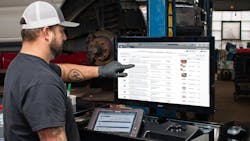How predictive maintenance can save fleets a fortune
Pitstop founder and CEO Shiva Bhardwaj, like many forward-thinking leaders, believes the future success of the transportation industry lies with predictive maintenance. And for good reason. A maintenance operation that leverages the burgeoning software tool, which prioritizes an asset’s diagnostic trouble codes based on historical data and sends alerts to decision makers, knows where to focus their efforts with a high degree of certainty.
Current predictive maintenance solutions like Pitstop’s platform can help fleets avoid unscheduled vehicle downtime by creating a vehicle health profile based on received diagnostic trouble codes and using data analytics to measure that against historical data.
“Our step-by-step process identifies issues, and then confirms how serious they are, and then you schedule vehicles in for service,” Bhardwaj said. “This is how we’re able to reduce downtime.”
And this is enabled by the multiple outputs, including sensors, ECUs, telematics, and maintenance management systems. The more data plugged into the algorithms, the more accurate the analysis.
“Any asset is spitting off a lot of info, telematics, and service data, and your mechanics, external or internal, are recording a lot of information about how they’re fixing these assets,” Bhardwaj explained. “When you bring these things together, you can make some smart decisions.”
With this newfound power to see the future, you can also succumb to the dreaded data overload, where too much of a good thing renders you directionless.
Bhardwaj has been told by customers that receiving all these fault codes “was too much,” so they stopped looking altogether.
“The key is not overwhelming with warnings,” he said, explaining that Pitstop “cuts through the noise” by providing, for example, three action items to address per week. “It’s not about putting more alerts in your hand, it’s about putting only the things that matter,” he said.
Because of its wide-ranging potential, it’s possible predictive maintenance will someday be as common as preventive maintenance or replace it altogether. While some fleets are already on that journey, others might be holding off, waiting for more data and certainty. The future is never 100% certain, but fleets that embrace predictive sooner rather than later will have an easier time once they get there, based on the sage advice Fleet Maintenance has gathered from several trailblazers in the space.
And their advice will hopefully enable maintenance departments to make the smartest decisions on how to proceed—decisions that could end up saving an operation a fortune.How predictive works
First off, it’s best to explain what predictive maintenance is and what it isn’t.
“The definition of predictive maintenance is that you’re using historical data to project what the future is,” said Jack Chung, VP of product management at Noregon Systems. In Noregon’s case as a diagnostic provider, their historical data comes from three decades worth of DTC big data, allowing them to predict how often a fleet will see other DTCs pop up as well.
“If you have three or more DTCs, that [might] narrow it down to a specific component,” he explained.
This then allows Noregon to assign a health score—color-coded red, yellow, or green based on severity.
This varies from conventional preventive maintenance, such as changing out tires or brake pads before they create issues on the road, which “is predictive in nature by using historical data, but without advanced analytics,” Chung said.
The level up from that is prescriptive maintenance, which along with historical data, actively measure the components condition in real time to predict a more accurate outcome, Chung explained, adding that “prescriptive maintenance can improve your business and ROI by adjusting the operating condition for prescribed outcomes and planned maintenance.”
“Prescriptive is the end goal that you want,” Chung surmised.
At its core, the AI-enabled technology does all the math for you and helps humans identify patterns they could not possibly have time to analyze.
Bhardwaj noted that for decades, technicians like his father (who now owns a commercial vehicle shop) have done this manually, but it requires combining what the driver says, what a road test reveals, and then troubleshooting until the problem is diagnosed. The more experienced the technician, the faster the process.
Pitstop does this by detecting critical fault codes and alerting maintenance managers who can then take action. This might mean calling the driver and telling them to find the nearest service facility or having the truck make it to the nearest terminal where technicians are standing by to make a repair.
Catching issues early can also help prevent forced regenerations in the aftertreatment system by acting on issues before the DEF inducement lamp turns on, which would be cause for a forced regeneration.
“The idea is to try to identify these critical faults before the regen situation is in place, and make sure that the driver comes into the shop, because otherwise you’re just going to have downtime,” Bhardwaj said.
One example is catching a NOx sensor issue at the terminal as opposed to when the driver is sidelined in the middle of nowhere. A fleet that only goes by OE-recommended preventive intervals might suffer the latter scenario, while a predictive-minded one can preempt the costs associated with roadside breakdowns [see pg. 14 for more on roadside breakdowns].
Jim Rice, VP of predictive solution provider Uptake, noted this happened with one Uptake Fleet platform customer “who changed NOx sensors every 200,000 [miles] come hell or high water.”
That’s what the OEM recommend, so they did it this way for several years. Uptake Fleet combined their VRMS codes, work orders, and data analytics to show what the real story was.
“We found they changed about 50 of those NOx sensors that didn’t need it, and there were 50 that did need it,” Rice explained. “There was one at 180,000 miles that needed it, there’s one at 210,000 that didn’t need it.”
Rice noted a fleet of 10 might not be ready for such sophistication—though there are levels of predictive insights they can take advantage of. And the larger the fleet, the greater the savings. By getting advanced warning of cylinder head failures, a food and beverage fleet of 50,000 turned $50,000 engine replacement catastrophes into manageable $3,000 repairs. This failure mode happened on 80 trucks, so in four months the fleet saved $1 million, according to Uptake.Fortune selling
Those “smart decisions” Bhardwaj mentioned often add up to saving fleets a lot of money. Pitstop’s predictive platform, for example, on average reduces users’ unscheduled vehicle downtime by 25%, while cutting per asset maintenance and operations expenses by $2,000 per vehicle annually. Bhardwaj noted this is a “conservative estimate,” and equates to a 10x ROI.
United Road found a 4x ROI with Uptake, though Rice said even 10-12x ROI is possible, depending on how many blown engines a fleet might have repaired in the past.
“If you run a pretty good maintenance shop, there’s still savings, but it may be closer to that 3 or 4x ROI,” he said.
There are soft ROI costs to consider as well. Rice noted how a broken-down tractor-trailer with a brand’s name on it is “not a good look” for the company, especially if that truck creates safety issues on the road.
“If I can eliminate breakdowns, there’s a soft ROI just from brand image, public relations, and things like that,” he said.
Uptake also claims its predictive platform, Uptake Fleet, improves customer uptime by 8%. Extrapolating that to the overall industry, the 12 billion tons of freight demand in 2021 could have been achieved with 288,000 fewer Class 8 trucks, according to Uptake. Some other stats Uptake boasts include decreasing roadside breakdowns by 20% and maintenance costs by 12%, while increasing technician efficiency by 9%.
The technician efficiency aspect comes from prioritizing assets that need maintenance based on what the ECM and historical data say, and not an OEM’s broad best guess.
Uptake’s customer that saved on the engine replacements is so confident in the software that they have integrated the predictive insights with their transportation management system to automatically create work orders, and the private fleet’s techs can work on issues as the trucks come back that night.
Rice said the leased model is maturing as well.
“There’s an extra couple layers of dynamics as to who owns the maintenance,” Rice said. “We have some companies that will sign up with us, and then will share the information with the leasing company.”
That data helps the leasing customers detect problems and figure out if the leasing company is responsible for the maintenance costs, Rice explained.
Noregon found a rental fleet using TripVision remote diagnostics, which provides health monitoring via DTCs, creating an additional revenue stream, according to Chung.
The rental company has employees monitoring TripVision fault codes and contacts the customer to alert them to critical issues, and then can also provide the maintenance.
“They’re charging for this service to their customer,” Chung said. “That’s a very creative way that we didn’t intend to have people using [TripVision].”
He reiterated what really drives the move to monitoring DTCs and predictive maintenance is “all about cost savings,” and even more will be had as predictive parts ordering comes into play.
“If you combine e-commerce, that’s a very good way to increase your parts efficiency, because you know that certain faults were going to occur before you have to do maintenance,” Chung noted. “If you know that, you can start looking at your parts inventory, and how you can reduce your stock, and how you can drive down cost.”
Rice noted tracking when fleets replace parts can also help them keep proper inventory levels. He said a fleet that swaps oil filters at 25 weeks can find how many trucks are approaching that interval, and ensure enough stock when that time comes.
“It really improves efficiency because you’re not waiting on parts,” Rice said. “Clean data allows you to now analyze not just the predictive maintenance side, but the predictive repairs and what it’s costing you, and when you need to repair it.”
While e-commerce platforms such as Daimler Truck North America’s Excelerator are also working toward becoming more predictive, it’s still being figured out.
At Heavy Duty Aftermarket Dialogue in January, DTNA director of parts marketing and strategy, Brad Williamson, noted once that happens, “We can save a lot of downtime if it’s scheduled downtime.”
He wouldn’t predict exactly when that time will come, but said, “We’re getting close.”A forecast you can count on
Pitstop’s Bhardwaj noted managers unfamiliar with predictive might be skeptical.
“There’s obviously skepticism [from fleets] who have been burned by software vendors promising things and then not getting stuff,” Bhardwaj said.
“They might think, ‘There’s no magic crystal ball in the world—how can I believe this?’” he said.
He said it’s better for now to look at the tool “like a weather prediction,” where meteorologists will give a best estimate on the weather based on data such as wind, precipitation, and temperature.
“Now for my next week, I can plan what to wear when I go outside,” Bhardwaj said. “It’s not 100%, but it’s much better to have a weather prediction than to not.”
And with this type of maintenance forecasting, a fleet can be alerted to future trouble even if the sky looks clear now, as that could merely be the eye of the storm.
“[Intermittent engine- or tire-related DTCs might not] mean anything for you to act on in the short term, but could escalate and get worse over time,” he warned.
Pitstop focuses on the DTCs that first indicate immediate danger, and then what the data says will likely lead to problems, which he demonstrated on the platform with real-world data.
“Based on the next 30 days, here are 70 vehicles that we’ve got to probably pay more attention to and within those, there’s some that have more potential to break down versus others, and we rank those in order,” he said.
Suggestions are then given, such as get to a shop right away or ask for driver input, who will have a much better sense of what’s happening with the vehicle in real time.
And while a five-day weather forecast ends up being about 80% accurate, Pitstop claims 94% accuracy for issues in general, and nearly 100% with “very rare, critical issues,” Bhardwaj said.
Uptake Fleet, which had 70% detection accuracy on all failure modes previously, used a new configuration to improve to 90% detection accuracy for the cylinder issue to save that large fleet so much money.
Data overload
“With any data-based solution, there’s a lot of data you need to filter out,” advised Jean-Phillipe Bertrand, operations director at Isaac Instruments, a telematics and ELD provider for the U.S. and Canada. He likened taking in all the raw data to drinking from a fire hydrant.”
Bertrand said to keep from being flooded with non-value data, a fleet should highlight only the data most important to their operations, especially if they are new to the technology.
A fleet should do this through KPI benchmarking and identifying the biggest cost center, and then choosing three or four specific areas and relevant fault codes to reduce cost, recommended Melanie Simard, Isaac’s director of compliance, client service, and technical support.
“This will establish your baseline when starting with a new solution,” Simard said. Various fleets might need to focus on tires one year and aftertreatment or fuel filters the next, she added, recalling her previous 20 years of fleet experience in Canada.
Once these are picked, a fleet should automate related reports, such as historical costs on costly components, and send those to key managers.
“If you’ve tackled three or four major maintenance points, then you can maybe add another code and another and build your program this way,” Simard suggested. “This way, you’re not inundated with data.”
She said for small fleets in particular, data overload can sink a predictive program. “When you have one maintenance person, you don’t want that person to start wanting to work on every single thing that they receive from the telematics.”
Fleets can also better validate the root cause of DTCs by integrating with a transportation management system and looping in electronic driver vehicle inspection reports (eDVIRs) to validate issues. A picture taken by a driver on a tablet, paired with the data, helps narrow down possible issues.
Isaac can work with fleets as small as 20 assets in Canada or 50 assets in the U.S.
“We still need the drivers’ eyes to report with the telematics,” Simard said. “Not all drivers have the same level of mechanical savvy, but with the pictures and with what you can do with the ELD, the fleet can look at the historical data of this truck [combined with] the pictures [and] that code. It’s all connected.”
Uptake’s Rice stressed that whatever solution a fleet chooses should match their capabilities, and the “Cadillac premium version” isn’t right for everyone.
Uptake has worked with fleets with 35 units using its analytics capabilities and telematics data fleets are likely already receiving.
“If you’re using very basic spreadsheets and whiteboards, it’s going to be very hard to transition to a very robust, completely integrated work order system with closed-loop functionality,” he said. “There are baby steps in between.”
Rice posed the prediction that someday, everybody will be running these algorithms ragged like digital thoroughbreds, and data efficiency will be as valuable as fuel efficiency. Whether that’s 10 years from now or 50 all depends on two things, he said.
First, as with all new technologies, people expect fully mature magic bullets out of the box, and get frustrated with the reality of product development. Users will have to temper their expectations.
“You’ll often see people trying to do too much too soon,” Rice noted. “It really becomes a little bit of a burden for them.”
And second, the momentum leaders in the industry must work together to find clear use cases and share the results.
“You need a few big names to say, ‘This is really doing it,’” Rice said. “And then what you see is kind of a waterfall effect and this fast momentum, which is what we’re expecting in 2023. I think it’s the next wave of big trucking technology.”
About the Author

John Hitch
Editor-in-chief, Fleet Maintenance
John Hitch is the award-winning editor-in-chief of Fleet Maintenance, where his mission is to provide maintenance leaders and technicians with the the latest information on tools, strategies, and best practices to keep their fleets' commercial vehicles moving.
He is based out of Cleveland, Ohio, and has worked in the B2B journalism space for more than a decade. Hitch was previously senior editor for FleetOwner and before that was technology editor for IndustryWeek and and managing editor of New Equipment Digest.
Hitch graduated from Kent State University and was editor of the student magazine The Burr in 2009.
The former sonar technician served honorably aboard the fast-attack submarine USS Oklahoma City (SSN-723), where he participated in counter-drug ops, an under-ice expedition, and other missions he's not allowed to talk about for several more decades.


